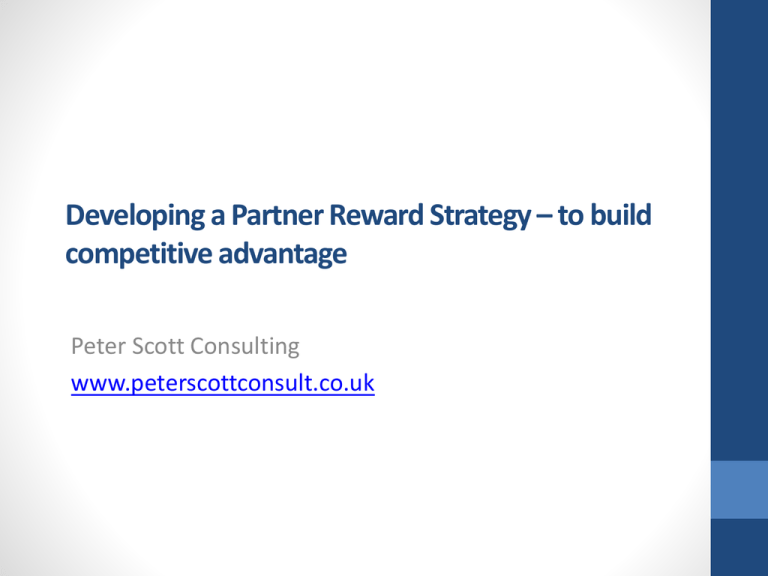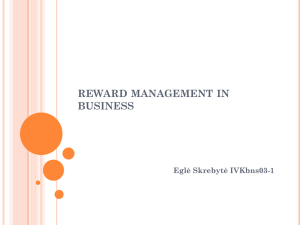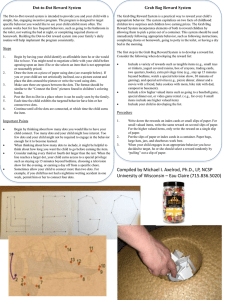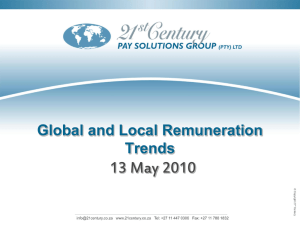Developing a partner reward strategy
advertisement

Developing a Partner Reward Strategy – to build competitive advantage Peter Scott Consulting www.peterscottconsult.co.uk Topics to be covered Putting reward into context Understanding how competitive rewards are personal Which system is best? Developing performance – based criteria Managing the process of appraisal Making the transition from one system to another 1. An appropriate reward system is strategic and should be seen as a component part of achieving competitive advantage over rivals To become more competitive than rivals a law firm will need to ….. consistently deliver what clients require – and do so better than rivals. To do this will mean ensuring a firm’s people perform at higher levels than rivals Essential to get the best out of people to maximise their potential and performance But - how skilled are law firms at getting the best out of their people? To do this will require a law firm to …. Understand what it really values and what it takes to succeed at the firm A firm should then invest in and reward what it says it values if it is to get the best out of its people to provide its clients with what they require What gets rewarded gets repeated Reward strategies are driven by the market Success depends on the ability to attract, retain and develop outstanding performers However, if a firm is unable to offer competitive rewards in its market then - it risks losing its best people - it will be unable to recruit the best In every legal market there is a threshold figure for average profit per equity partner (PEP). Below that threshold a firm will be at risk of losing its best people 2. Competitive rewards are personal For example, consider why partners leave law firms? Reputation / profile of firm Defined vision and strategy Culture Money Career prospects Quality of work / clients Feeling valued / relative worth Am I in the wrong firm? Feeling ‘valued’ Firms should not underestimate the importance of the need to feel ‘valued’ ‘I am not being paid what I am worth’ It is often relative worth which matters more ‘I am worth more than he is’ A reward system should aim to determine the relative contribution of each partner with respect to other partners 3. Which system is best? No such thing as a perfect system One which works well for one firm may be a disaster for another firm A system should be regularly reviewed to meet the changing needs of the firm as it seeks to achieve its competitive advantage Which system? - traditional lockstep? - modified lockstep involving performance – based elements? - ‘eat what you kill’? What is a firm trying to achieve? Objectives of a partner reward system? A well designed partner reward system should – be aligned with a firm’s strategic goals help maintain a firm’s competitive position in the recruitment market provide rewards which recognise each individual’s relative ‘worth’ help create a culture of higher performance and sharing encourage the development of new skills within a firm Profitability is key No reward system can make up for a lack of profitability What is the market average PEP threshold? Below that threshold a firm is ‘at risk’ of not being able to retain and recruit the best A profit improvement plan may need to be implemented in parallel with developing a reward strategy Traditional lockstep Still a common form of sharing profits and rewarding partners in many firms Progress up the lockstep is by reference to seniority as a partner, usually linked to increasing capital contributions Top of the lockstep is a plateau with equality – until retirement. Traditional lockstep Advantages? - collegiality / culture - easy to manage Disadvantages? - may not ‘fairly’ match reward to contribution - may not measure ‘relative worth’ - only works if everyone ‘pulls their weight’ - can be inflexible Performance-based reward should ideally …. Be consistent with and advance the goals of the firm Determine the relative contribution of each partner with respect to other partners Have strong emphasis on performance (but not just personal billings) Differentiate between high and average performers NB - underperformance should be addressed separately An example of a modified lockstep with a performance – based element Elements of a performance-based system Should establish individual partner goals and plans Should attempt to move partners to strengths and away from weaknesses Can be ‘weighted’ to help a firm achieve its objectives from time to time Should involve sustained performance over a period Not too many moves up or down Provide for large differentials between levels and between top and bottom 4. Developing performance criteria Performance criteria are fundamental to developing a reward strategy and should be designed to advance a firm’s competitive goals by helping to develop, for example Skills and expertise Client service Enhancement of firm’s reputation Market share Enhanced financial performance A culture of sharing How to develop reward criteria? Involve partners in clarifying criteria to define ‘high performance’ Partners will then feel they ‘own’ the process Will provide greater transparency for future partners Focus on what will help the firm to achieve its goals “What will it take to succeed at our firm?” Examples of performance criteria Developing / maintaining client relationships Technical ability Commercial awareness Business development Relationships with colleagues Personal attributes Financial management 5. Managing the process of appraisal Do you have performance development reviews? How effective are they? Effectiveness of different types of performance development reviews? - downward only once a year? - on – going / informal? - 360 degree (all round) feedback? Performance development reviews Need to be part of an on - going performance management process and reward cycle Can be used to support a particular development programme Should aim to provide each partner with an agreed and actionable performance development plan and serve as a basis for reward 360 degree (all round) feedback? Can involve Feedback from those you report to Feedback from your peers Feedback from staff who report to you to provide an all-round perspective of performance. A typical 360° performance development review process Obtaining feedback from colleagues can be an essential stage… to build on peoples’ strengths and to reinforce what they are already doing well to identify what they could do better Set objectives Monitor & support Process Obtain feedback To form the basis for reward Development plan Appraisal meeting Report to partners Advantages of 360 degree (all round) feedback to evaluate performance? Who better to give feedback on peoples’ performance than their peers and the people with whom they work closely? Compared with downward only feedback – - More constructive - Better received - More effective to enhance performance or change behaviour 6. Making the transition from one system to another – for example from a traditional lockstep to performance – based reward Be clear as to what you are seeking to achieve Trust is essential Can be very difficult - go slowly Minimise changes first year / dry run option Above all, communicate Moving to a performance based reward system Involve partners in the development of the reward system and process Explain its purpose, benefits and how it will work Must be a process to which partners are willing to commit - do not seek to impose it on partners Partners must fully support the process if they are to change as a result The process must not be seen as threatening Who should evaluate performance and decide on reward? No single best way to do this – whatever way best suits your firm trust is essential management must have significant representation and influence involve trusted non-management individuals or a ‘non – exec’ for checks and balances Any questions?











